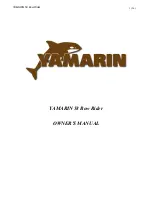
TartTarta
12.6
Standing Rigging
Standing rigging is defined as those fixed parts of the rigging, which support the mast. The standing
rigging and all the components listed under "Stainless Steel" should be checked each time before
going sailing and given a detailed monthly examination. Turnbuckles should be inspected to make
sure that cotter pins are in place at top and bottom, that cotter pin ends are turned back carefully and
that they are covered with plastic tape. Each spreader should be checked that the pins are properly in
place and that the spreader is not out of alignment. The end of the spreader where the shroud passes
through should be padded with a piece of foam and taped over to prevent chafing sails. Any stranded
wire rigging should be checked for broken, protruding strands. Check also for any signs of rust in
wire rigging. A good practice is to paint a small white ring around the wire where it enters the
terminal. The paint will show if any slippage occurs and will prevent salt from collecting in the
minute spaces between the strands, which will induce corrosion. Examine carefully where the wire
enters the terminal end fitting for signs of rust or wear since this is a particularly vulnerable point
when the yacht is sailed in salt water. If signs of rust or wear are found, the rigging should be
replaced. Rod rigging should be examined for nicks or kinks and any signs of fatigue where the rod
enters the terminal end fitting. If any potential problem is found, consult your Tartan Dealer.
12.7 Running Rigging
Running rigging comprises the gear that is normally used in handling and trimming sails such as
sheets, guys, halyards and vangs. Main and genoa halyards are subject to heavy loading and constant
flexing as they pass over the sheave at the head of the mast and turning blocks at the foot of the mast.
Rope halyards are typically not subject to wear as severe as wire halyards, but should be examined
several times each season. The end fitting should be checked each time the yacht is sailed to ensure it
closes and locks smoothly and securely. The splice at the end fitting should also be checked with each
sail. Rope sheets tend to fray over a period of time and should be replaced when any strand of the
outer layer of braid begins to fray.
12.8 Lifelines, Pulpits and Stanchions
Lifelines, like standing rigging, should receive regular, periodic inspections. The terminal ends at the
connector must be well screwed into the barrel in order that all the threads of the barrel are fully
engaged. The lock rings must be installed. Check the swaged ends for signs of rust. Check pulpits and
stanchions for dents or cracks. Ensure that they are properly secured into their bases.
12.9
Winches and Blocks
Most problems which develop in winches are due to insufficient or improper maintenance. When
sailing in salt water, winches should be stripped down, cleaned and lubricated no less than once a
month. In fresh water areas this maintenance procedure should be performed at least twice each
season. The bolts securing the winches should be checked at least once each season. Access to the
bolts which secure the cockpit winches may be gained by removing the winch drums. Bolts securing
the winches on the coachroof may be checked by removing the winch drums as well. If it is necessary
to remove a winch base and remove the bolts, the bolts should be resealed with marine sealant.
Blocks normally require little maintenance, but they should be examined regularly for damage, particularly
at the shackle connection. Never leave a snatch block open, and be sure the snatch is properly closed before
Summary of Contents for 3700
Page 12: ...T3700 H AR KE N U S A R...
Page 13: ......
Page 14: ...DECK LAYOUT Spinnaker Gear...
Page 15: ...DECK LAYOUT Vang and Spinnaker Gear...
Page 16: ...ACCOMMODATION PLAN...
Page 20: ...1 BATTERY WIRING SCHEMATIC...
Page 22: ...PROPANE LEAK DETECTOR...
Page 24: ...AIR CONDITIONER LAYOUT Single Unit...
Page 25: ...THRU HULL LAYOUT...
Page 26: ...TANKAGE...
Page 30: ...CCR RIG WITH REACHER 12 4 07 TJ...
Page 31: ...Stability Curve...
Page 65: ...TartTarta Tartan Yachts Commissioning Checklist...














































